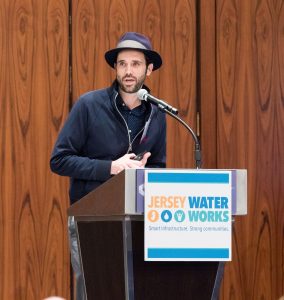Water leaders call for continued momentum, innovative funding to transform New Jersey’s water infrastructure
Throughout 2019, New Jersey’s water infrastructure has made headlines. With the Jersey Water Works Lead in Drinking Water Task Force recommendations advanced by the state legislature, a new stormwater rule requiring green infrastructure finalized by the New Jersey Department of Environmental Protection, and local governments now having a new funding option to manage stormwater utilities, the Jersey Water Works collaborative has been on the front lines for all of the challenges and policy wins. At a time when water infrastructure in our state had gathered attention from the media, community members, and local and state officials, the 2019 Jersey Water Works Conference, held on December 12, seemed more relevant than ever.

The fifth annual Jersey Water Works Conference gathered 315 water leaders, advocates, and professionals to share ideas, explore infrastructure solutions, and celebrate the progress of the collaborative. Several speakers emphasized the power the diverse collaborative has in achieving its shared goals—investing in sustainable, cost-effective solutions that provide communities with clean water, safe neighborhoods, and economic growth— when coming together to continue conversations around water. “Every step of the way, Jersey Water Works has been involved in helping all our stakeholders to achieve these goals,” said Jersey Water Works co-chair Jane Kenny.
Sharing information to build relationships grounded in trust

They key to any group of people successfully advancing their goals is communication. For Jersey Water Works, that doesn’t just mean communication between engineers, policy makers, and water professionals. “Who are the communities not yet at the table? What are the questions not being asked?” questioned John Keller of coLab Arts. By practicing open and consistent communication, utilities can build and maintain strong relationships with the communities they serve. Panelist Jennifer Gonzalez, director of environmental services and chief sustainability officer for the City of Hoboken, said that relationship building is essential to tackling water infrastructure projects; these projects are too big for one municipality or utility to undertake, and the issues cross political boundaries and go beyond town, county, and state borders.
The water infrastructure industry tends to be cautious when it comes to a willingness to share information, noted Melissa Elliott. As director of strategic communication services at Raftelis, a utility and public-sector consulting firm, she noted that she’s seeing a lot of collaborations bringing people in the room that may not always be at the same table, like Jersey Water Works. By doing so, it creates a platform to try new ideas from other sectors. “Telling our story about infrastructure is really critical,” said Elliott, and one of the best parts about the water sector is that “we share information with each other” to make that happen.
Keynote speaker George Hawkins, founder of Moonshot Missions, has seen the positive effects of bringing in new ideas and approaches from other sectors. When he was serving as chief executive officer and general manager of DC Water, Washington D.C. had a history of problems with lead in drinking water since the early 2000s. When there was an issue with the corrosion control, lead from the pipes leached into the drinking water supply. DC Water knew they had to act fast and talk to the people impacted. Hawkins said, “We were responsible. We made a mistake.” Although people were not happy, they were appreciative that they knew what was going on with their water supply. Hawkins explained that they received positive feedback when sharing information with the community, even though the information itself was about a grim situation. “Communications is a huge part of that, and it’s counterintuitive,” he noted.

There are some clear similarities between the challenges Hawkins shared in Washington D.C. and what Newark was facing at the end of 2019. Kareem Adeem, acting director of the City of Newark Water and Sewer Utility, shared how Newark is working hard to keep residents informed on the city’s progress with the lead service line replacement program with website updates, online outreach, and signs around the community.
The challenges Newark has been facing with lead in its drinking water supply isn’t an isolated situation. “Newark is not alone by any stretch,” Walter Mugdan emphasized. As the deputy regional administrator for the United States Environmental Protection Agency Region 2, Mugdan knows that throughout New Jersey, and around the country, communities are struggling to upgrade their water infrastructure. He said, “EPA remains dedicated to working together with DEP and the City of Newark to support longer-term solutions.” Walter identified the six areas that the EPA is focusing on as they move forward to address lead in drinking water: identifying the communities that are the most affected, strengthening treatments in response to lead poisoning, replacing lead service lines, increasing sampling liability, improving communication to the public, and protecting children in schools.
When a mistake is made, people don’t want to feel like they’re being kept in the dark. But transparency isn’t just beneficial to residents—it helps utilities, local governments, and economies to be successful. “The best method to achieve success is to maintain transparency,” said Rich Calbi, director of operations of Ridgewood Water. By being transparent and vulnerable, we can build and grow connections built on trust and reliability, rather than out of fear. George Hawkins explained that trust has to be the foundation of water work, saying, “nothing we seek to do on these issues work unless all of the people, and the instructions that connect to us, trust us.”
Hawkins explained that trust starts with being honest and direct when a problem arises, even if it reveals vulnerability. Particularly if it reveals vulnerability, even though the instinct is to hide it. “By revealing a vulnerability, you’re making the opening of a connection with someone,” he said.

Innovative solutions for emerging problems
Our water infrastructure goes unseen until something is wrong, which is one of the biggest challenges when it comes to gaining momentum behind investing in that infrastructure. When a water main breaks, everyone can agree that something needs to be done—and fast. However, crumbling, aging, antiquated water infrastructure is not as easy to gain quick support for investment. Rebuilding New Jersey’s inadequate water infrastructure is an important endeavor, but it requires a lot of funding. And it isn’t only going to cost a lot in New Jersey: Mugdan explained that a 20-year investment needed to modernize and update the drinking water, stormwater, and wastewater infrastructure in the United States could cost $745 billion. Mugdan shared some financing options like the State Revolving Funds (SRF), the Water Infrastructure Finance and Innovation Act (WIFIA), and the Water Infrastructure Improvements for the Nation Act (WIIN). He said that the New Jersey Infrastructure Bank has been invited to apply for a WIFIA loan of up to $149 million.

“We know that in New Jersey, there’s probably at least a billion dollars invested in water infrastructure,” said Dan Kennedy, director of environmental and utility operations at the Utility and Transportation Contractors Association. Kennedy emphasized the need for local, state, and federal government to have an honest conversation about how to fill the investment gap in New Jersey’s available water infrastructure funds to achieve a manageable increase of funding for the upcoming year. A concern utilities and local governments have with funding these water infrastructure projects is how to avoid raising rates.
Both Kennedy and Hawkins cited Camden County Municipal Utilities Authority (CCMUA) as an example of how funding capital improvement projects without raising rates is possible. Hawkins said that CCMUA has been able to identify where there are opportunities to evaluate and improve upon existing metrics, like optimizing flow distribution, to save a utility money. When a utility saves money, their ratepayers can save money as well. This is especially important in low-income communities; throughout New Jersey, there is a strong correlation between low income communities and communities that require expensive infrastructure upgrades to fix problems like lead service lines, combined sewer systems, and aging water infrastructure. Hawkins emphasized the importance of continuously tracking metrics and searching for opportunities to make projects more efficient, encouraging utilities to ask “What are the numbers? What’s our benchmark?”
What other options do utilities have? Gonzalez is familiar with Hoboken’s vulnerability to coastal flooding events and drinking water reliability issues due to its aging water infrastructure; her work focuses on mitigating rainfall flooding. Hoboken has adapted to thinking of water holistically, with a One Water approach, to address policy, planning, and capital projects in an integrated way. When exploring ways to shift the focus around traditional funding and search for water funding around a new framework, like transportation or resilience, she encouraged us to “look at these projects as more than water projects… What we think of as barriers are actually opportunities to look at the project differently. What can you add to the project that will make it a multi-benefit project?”

Another area of note, with opportunities to explore new and innovative solutions, is the growing concern of emerging contaminants. In March 2019, Jersey Water Works released a fact sheet on per- and polyfluoroalkyl substances (PFAS) outlining how these substances can get into our water supply and environmental media, the associated health effects, and how they are regulated and monitored in groundwater and drinking water. The EPA also released a PFAS action plan, including short- and long-term responses. Currently no PFAS chemicals are included in the list, meaning that companies are not required to report it to the Toxic Release Inventory. This would be an important first step in regulating these emerging contaminants.
According to Mugdan, the Environmental Protection Agency also proposed regulatory determination for PFAS and PFOA for interagency-review. If the EPA makes a final positive regulatory determination for these contaminants, Mugdan explained that they’ll then begin the process to establish a primary national drinking water contaminant. Rich Calbi advocated for the need to address emerging contaminants, saying to utilities, “They’re the next lead.”
This year’s conference provided the opportunity to dive deeper and explore innovative solutions in a new way with three afternoon breakout sessions. With each session focusing on a different topic – lead in drinking water, DEP’s new green infrastructure requirements, and Camden’s equitable water future – panelists identified exciting opportunities and challenges in their work to achieve equitable, safe, and multi-benefit water systems.
Making progress

While it can be easy to feel overwhelmed by the daunting task at hand, it’s still important to celebrate the successes and accomplishments. Jersey Water Works members announced over 30 commitments – actions they will take to transform our state’s water infrastructure throughout 2020. By announcing commitments, Jersey Water Works’ members demonstrate their dedication to the issue of water infrastructure and put their voices together to show leaders around New Jersey the continued importance of water infrastructure to our future. To track progress being made through metrics on each of Jersey Water Works’ 13 goals, the collaborative announced the upcoming September 2020 release of the data dashboard.
Emphasizing the opportunity to continue upon Jersey Water Works’ momentum, Jane Kenny said, “550 people are making an amazing difference in this state.” Calbi noted the momentum that water infrastructure has gained through 2019, “Drinking water might be what finally breaks the back of home rule in New Jersey.”